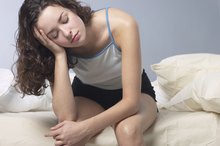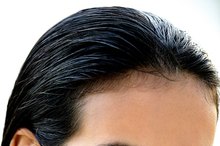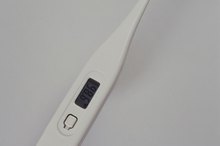Fever After Exercise
Normal body temperature is about 98.6 Fahrenheit, but it may vary slightly depending on your own normal temperature, the time of day and how the temperature is measured. It is normal for body temperature to increase during exercise, and it may still be above normal immediately after finishing physical activity. Drink lots of water and don't let yourself get overheated to prevent dehydration and heatstroke that can raise your body temperature to dangerous levels. A persistent fever can be a sign of an illness that requires medical attention.
Body Temperature and Exercise
Dr. Gabe Mirkin writes on his website that many weightlifters have temperatures up to 101 degrees during sessions. Marathon runners can have temperatures up to 103.8 degrees on cool, 50-degree days. Temperature naturally rises as you exercise and continues to increase the harder you exercise, as more than 78 percent of muscle energy is lost as heat. Immediately following your workout, your temperature will usually be elevated, but it goes down quickly as you hydrate and cool off.
- Dr. Gabe Mirkin writes on his website that many weightlifters have temperatures up to 101 degrees during sessions.
- Immediately following your workout, your temperature will usually be elevated, but it goes down quickly as you hydrate and cool off.
Fever
Menopause & Chills
Learn More
You may have a fever for many reasons, including illness, being in a hot environment, exercising vigorously or becoming dehydrated and suffering from another heat-related illness. A fever is generally considered to be a temperature of 99.5 degrees or higher when taken orally and 100.4 degrees or higher when taken rectally. It is normal to have a fever during and immediately following exercise, but seek medical attention if the fever persists even after you are rested.
Heatstroke
If you are not properly hydrated during exercise and get too hot, you can become dehydrated, leading to heatstroke. Heatstroke is a serious heat illness and a medical emergency requiring immediate attention. If you exercise vigorously in a hot environment and are not drinking enough to sweat and cool yourself down, your body temperature may rise too high and cause heatstroke. Heatstroke can cause a temperature of 104 degrees or higher, a headache, dizziness, disorientation, rapid breathing and pulse, and muscle weakness or cramps.
- If you are not properly hydrated during exercise and get too hot, you can become dehydrated, leading to heatstroke.
Heatstroke Prevention
Why You May Feel Tired in Summer Weather
Learn More
To prevent heatstroke as a result of physical activity, don't exercise vigorously in a hot gym or outside on hot days. Drink plenty of water to stay consistently hydrated -- don't wait to become thirsty. Finally, stop exercising if you experience any of the symptoms of an extremely high body temperature and heatstroke.
Related Articles
References
- University of Illinois Medical Center: Fever
- Medline Plus: Heat Emergencies
- Vaidyanathan A, Malilay J, Schramm P, Saha S. Heat-related deaths — United States, 2004–2018. MMWR Morb Mortal Wkly Rep 2020;69:729–734. doi:10.15585/mmwr.mm6924a1
- Davis RE, Knappenberger PC, Novicoff WM, Michaels PJ. Decadal changes in heat-related human mortality in the eastern United States. Clim Res. 2002;22(2):175–84. doi:10.3354/cr022175
- National Institute on Aging. Cold weather safety for older adults. Updated January 1, 2018.
- Johns Hopkins Medicine. Heat-related illnesses (heat cramps, heat exhaustion, heat stroke). 2020.
- Wexler RK. Evaluation and treatment of heat-related illnesses. Am Fam Physician. 2002;65(11):2307-2314.
- American Academy of Dermatology. Sunscreen FAQs
- Centers for Disease Control and Prevention. Tips for preventing heat-related illness. Updated June 19, 2017.
- National Safety Council. Hot car deaths. Updated 2020.
Writer Bio
Jackie Carmichael has been a freelance writer for more than 10 years. Her work has appeared in "Woman's World" and "American Baby" magazines. Carmichael is a licensed registered nurse and has worked in fields related to cardiovascular health and psychiatry. She also holds a Bachelor of Arts in journalism from The Ohio State University.









